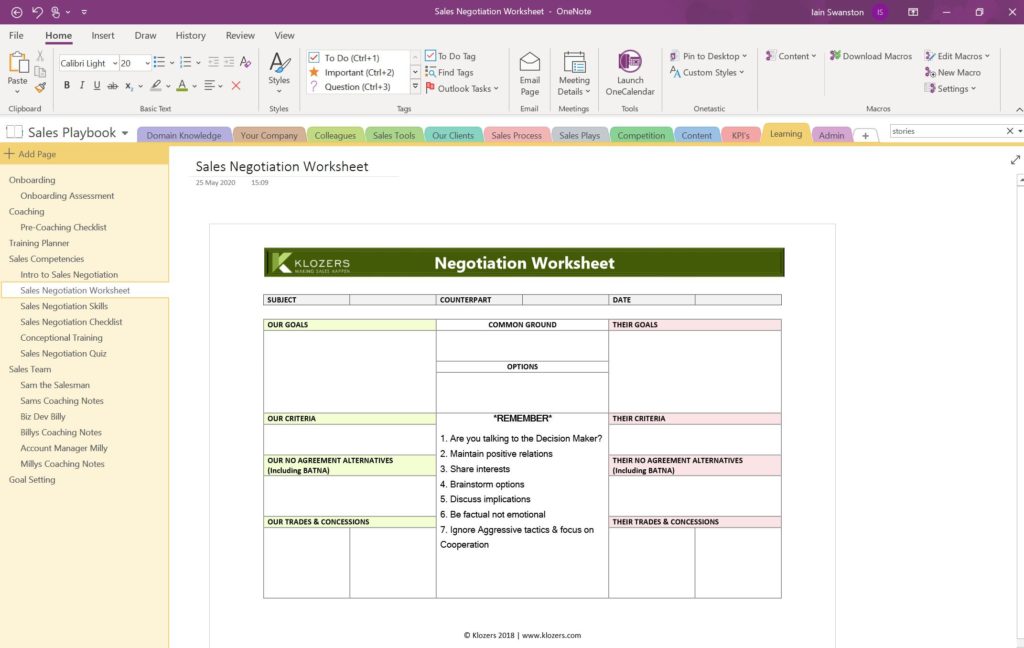Key Negotiation Skills – Introduction
There is a common misconception that sales negotiation skills are only required towards the end of the sales process. The part in every sales process where costs and terms are agreed. Whilst this is undoubtedly true, it’s also true that the best salespeople are negotiating all the way through the sales process. In fact every Professional salesperson negotiates, every single day which is why it’s an important part of any training programme.
From negotiating with their children on what to have for breakfast, to negotiating with a Partner on where to go for dinner. In between times they will negotiate workloads with their line managers, negotiate meeting times with co-workers, negotiate dates & times for appointments with prospects and lastly negotiating sales contracts, project delivery and aftercare contracts. In short, Negotiation is actually unavoidable, and the ability to Negotiate is a core skill for every Salesperson.
Planning for Sales Negotiations
Like most things in life when it comes to Negotiation knowledge is power. The more information you have and better prepared you are then the more likely you will achieve a successful negotiation. Follow the information below to discover how to research and plan your next negotiation.
Sales Negotiation Goals
These are the needs, wants and desires of the parties involved in the negotiation. In business this can be complicated as not only may both sides have differing goals, but parties within each side may have differing and even conflicting Goals.
Goals can be subjective for example “We need to increase the confidence of our people.” or they can be more objective like “We need to reduce our overheads by 10 this quarter”. Either way it’s important to know both your own Goals and that of the other side. Important questions you must ask are:
- Have we identified all the Goals?
- What are the Prioritised Goals?
- What are the Business Goals?
- What are the Personal Goals?
- Are there conflicting Goals?
| Business Goals Examples | Personal Goals Examples |
| Strategic | Security |
| Change | Satisfaction |
| Growth | Peer Pressure |
| Improvement | Financial Gain |
Please note Goals are NOT the same as outcomes.
Example:
Goals – George is 65 years old and would like to retire (Goal). In order to fund his retirement he needs to sell his business but no one wants to invest a large sum of capital. Mike would like to buy a business (Goal) but does not have any capital to invest.
The Outcome is the Negotiated agreement that they come to.
Negotiation Options
These are all the possible solutions that satisfy the goals of both parties. They are all possibilities that both parties agree or say Yes to.
By investing time to explore all the Options then you are more likely to find:
- Alternative solutions
- Enable both parties to achieve their goals
- Reach the Best Possible Agreement (BPA)
Example:
Goals – George is 65 years old and would like to retire (Goal). In order to fund his retirement he needs to sell his business but no one wants to invest a large sum of capital. Mike would like to buy a business (Goal) but does not have any capital to invest.
Option – George can sell his business to Mike but rather than invest a lump sum he agrees to pay George on a Monthly basis from the profits for the next 5 years and hence fund his retirement.
Criteria for Negotiation
Criteria are the “terms” of any possible Option
Example:
Goals – George is 65 years old and would like to retire (Goal). In order to fund his retirement he needs to sell his business but no one wants to invest a large sum of capital. Mike would like to buy a business (Goal) but does not have any capital to invest.
Option – George can sell his business to Mike but rather than invest a lump sum he agrees to pay George on a Monthly basis from the profits for the next 5 years and hence fund his retirement.
Criteria – George needs to guarantee a minimum payment every month regardless of the profitability of that month. Mike needs to ensure ensure he will not be liable for any warranty, liability or compensations claims from the period before he take responsibility/ownership of the business.
Get expert Sales Negotiation Training from our Sales Coaches
CNA – Cost of No Agreement
Not all Negotiations end in an agreement, it is therefore vital before entering into any Negotiation that you first work out what the Cost of No Agreement is for both parties. The costs of no agreement can be both Objective and Subjective.
Example:
Goals – George is 65 years old and would like to retire (Goal). In order to fund his retirement he needs to sell his business but no one wants to invest a large sum of capital. Mike would like to buy a business (Goal) but does not have any capital to invest.
Option – George can sell his business to Mike but rather than invest a lump sum he agrees to pay George on a Monthly basis from the profits for the next 5 years and hence fund his retirement.
Criteria – George needs to guarantee a minimum payment every month regardless of the profitability of that month. Mike needs to ensure ensure he will not be liable for any warranty, liability or compensations claims from the period before he take responsibility/ownership of the business.
CNA – George does not have the financial resources to retire (Objective) however he has been trying unsuccessfully to sell his business for three years and is now desperate (Subjective) for a solution. Mike is keen to buy a business (Objective) but knows there are hundreds of businesses for sale and he is pretty relaxed (Subjective) if this deal doesn’t go through another one will come along.
The Subjective Cost of No Agreement can be more powerful than the Objective ones as people make decisions emotionally and then justify their position intellectually afterwards.
BATNA – Best Alternative to No Agreement
Not all Negotiations end in an Agreement, it is therefore vital before entering into any Negotiations that you first work out what the Best Alternative to No Agreement is. In some cases you may well experience that the other party is so entrenched in their position that they have no desire to Negotiate. BATNA is typically but not always, an alternative course of action that can be taken if no agreement is reached.
BATNA helps you prepare for a Negotiation by:
- Helps prevent you from agreeing to something you will regret
- Defining your Minimum Possible Agreement (MPA)
- Provides you with a Plan B
- Helps prevent you from over or underestimating the your own and the other party’s position
- Helps you understand where the leverage is
- Identifying alternative Options
Example:
Goals – George is 65 years old and would like to retire (Goal). In order to fund his retirement he needs to sell his business but no one wants to invest a large sum of capital. Mike would like to buy a business (Goal) but does not have any capital to invest.
Option – George can sell his business to Mike but rather than invest a lump sum he agrees to pay George on a Monthly basis from the profits for the next 5 years and hence fund his retirement.
Criteria – George needs to guarantee a minimum payment every month regardless of the profitability of that month. Mike needs to ensure ensure he will not be liable for any warranty, liability or compensations claims from the period before he take responsibility/ownership of the business.
CNA – George does not have the financial resources to retire (CNA) and has been trying unsuccessfully to sell his business for three years and is now desperate for a solution. Mike is keen to buy a business and has spent £3,000 with Solicitors and Accountants thus far completing his due diligence on the company.
BATNA – George is in discussion with his Lawyers to explore the possibilities of a Management Buyout for the business. Mike knows there are hundreds of businesses for sale and he is pretty relaxed if this deal doesn’t go through another one will come along.
Concessions for Negotiation
A concession is something given to the other party in furtherance of the agreement. These concessions should be identified in advance and segmented for both parties in terms of:
High Value – High Cost
High Value – Low Cost
Remember – Never give anything away without receiving something of equal or greater value in return.
Example:
Goals – George is 65 years old and would like to retire (Goal). In order to fund his retirement he needs to sell his business but no one wants to invest a large sum of capital. Mike would like to buy a business (Goal) but does not have any capital to invest.
Option – George can sell his business to Mike but rather than invest a lump sum he agrees to pay George on a Monthly basis from the profits for the next 5 years and hence fund his retirement.
Criteria – George needs to guarantee a minimum payment every month regardless of the profitability of that month. Mike needs to ensure ensure he will not be liable for any warranty, liability or compensations claims from the period before he take responsibility/ownership of the business.
CNA – George does not have the financial resources to retire (CNA) and has been trying unsuccessfully to sell his business for three years and is now desperate for a solution. Mike is keen to buy a business and has spent £3,000 with Solicitors and Accountants thus far completing his due diligence on the company.
BATNA – George is in discussion with his Lawyers to explore the possibilities of a Management Buyout for the business. Mike knows there are hundreds of businesses for sale and he is pretty relaxed if this deal doesn’t go through another one will come along.
Concessions – George is prepared to spend 3 months of his time ensuring during the handover period which is Low Cost to him as he will be retired but High Value to Mike as he is new to the industry and recognises the benefit of George’s experience.
Mike is prepared to move quickly which has no cost to him however this is High Value to George as the last thing he wants is a long protracted sale.
Negotiation Strategies
Aggressive Tactics
- Shoot the hostage
- This strategy is extremely aggressive as it involves an immediate offer to walk away with no deal which is designed to throw and unsettle the other party. This is often delivered in a reluctant tone “we don’t want to do this but…”,
- Delaying tactics
- When time is clearly on one parties side the process can often be deliberately slowed which is extremely effective when there are cost implications if talks over run. This tactic also applies if the other party has another meeting or needs to leave. The negotiator deliberately talks around the subject to delay the real conversation and then uses time to put pressure on the other party to come to an agreement.
- Poor Me
- This strategy is used to play the false victim that needs rescued by the other party.
- Last Minute.com
- As the name suggests this strategy involves the Negotiator agreeing to a solution right up until they are required to sign and then withdrawing. The withdrawal is usually followed up quickly with a counter offer at dramatically reduced terms.
- Misleading/lying
- Often Negotiators will make exaggerated claims or even lie so without hard data to support them you should discount these. They may also issue warnings and threats or make matters personal to unbalance you.
- Missing People
- Everyone knows the importance of having all the Decision Makers in the room but Negotiators may even turn up with complete strangers. In sales some companies will remove Sales People from the final negotiations. If the Sales People have a relationship with the other party they could be more empathetic and weaker negotiators. Turning up without warning with complete strangers also unbalances the other party.
Co-operative Tactics
- Agree on the Process
- Spend time up front agreeing the process and format of the Negotiations including what’s in scope and what’s not.
- Win Win Agreements
- Most professional Negotiators accept that any final agreement must be fair and sustainable for the life of the time period. In most business scenarios it should never be win at all costs as this destroys relationships.
- Matching Rights
- Offer the other party the right to match any solution that you receive. For example if one of two business partners decides to sell their shares to another party they may have the agreement that the other party gets first refusal if they match the offer.
- Contingent Agreements
- These are simply agreements based on future events. Financial Bonus may be tied to Performance. Football transfer fees can be include Contingent Agreements that provides the selling club additional revenue if a player is sold on and or if a player is capped by their country or simply makes a certain number of appearances.
- Multiple Offers
- When multiple offers are placed on the table this allows both parties to indicate preferences and encourages creativity as a winning hybrid offer can be formed. Placing one offer on the table often leads to a refusal and a stall in the process.
Sales Negotiation Checklist
1. Be prepared to walk away. Sales Negotiation is 70% Mindset and 30% Strategy and unless you are prepared to walk away, no strategy will help you.
2. It’s not what you charge it’s what your worth. Thoroughly research the market and discuss with the buyer the Value you bring to the table?
3. Take council from colleagues and external advisors and agree a pre-meeting strategy for the negotiations then PRACTICE.
4. Never give anything away without receiving something of equal or greater value in return.
5. Never enter a Negotiation without first providing your price and outline terms in advance, to anchor the prospect to a higher number and terms.
6. Where possible in high value deals do not include your sales people in Negotiations, as they will be emotionally involved in the sale and not objective.
7. Ensure everyone in your team have agreed in advance your trade-offs, your concessions, and your best alternative to a negotiated settlement.
8. You must be comfortable with silence and at most only talk 30% of the time, as the more you talk the more information you are giving away.
9. If it’s not Win Win then you run the danger of the prospect backing out or failing to implement your agreement, then the lawyers are the only winners.
10. Negotiation is between human beings, you must therefore be familiar with Human Psychology, DiSC, Neuro Linguistic and Programming.








